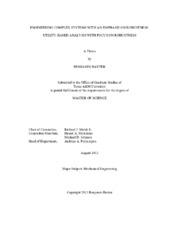| dc.description.abstract | Engineered system complexity continues to increase rapidly, concurrent with the requirement for the engineered system to be robust. Robustness is often considered a critical attribute of complex engineered systems, but an exact definition of robustness is not agreed upon within the systems engineering community. Lack of a clear definition, makes it difficult to develop or utilize a quantitative measure of robustness. Having a formal measure for robustness may not be considered necessary, but a lack of a specific measure results in the inability to communicate the desired level of robustness, inability to measure how various options impact robustness, and makes it difficult to measure tradeoffs between robustness and other engineering parameters.
The objective of this research is to examine robustness and how it can be attained in systems engineering. In order to accomplish this objective, data from several scientific communities is examined to develop the meaning of robustness. While definitions between and even within each community differ, a key attribute is present in each definition: A robust system needs to maintain its core functions in the presence of internal and external changes. The key component of the characteristic is that each function within a system has its own measure of robustness.
When robustness and engineering are discussed, Robust Design must be examined. The scientific community uses variance as its measure for robustness. The Robust Design method has the adverse characteristic of forcing preferences upon the designer. Examining the mean-variance approach with utility theory shows that it imposes an increasingly risk averse position upon the designer. This position may not be compatible with the designer’s true risk attitude, causing issues when applying the method.
To contend with this issue, a novel utility-based approach is suggested. The approach focuses on generating functional models of the proposed systems, which provide the designer with insight into which perturbations are relevant to the system and subsystems. Additionally this approach incorporates utility theory to allow the designer to convey their preferences. The utility-based approach allows the designer to convey their own preferences, while incorporating steps to ensure the final design is robust. | en |


